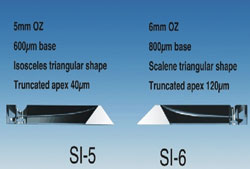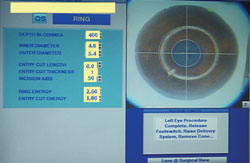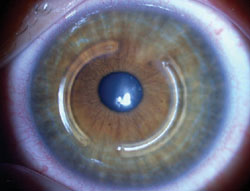Intracorneal ring segments implanted with femtosecond laser can treat keratoconus
The device is available in two models that vary in terms of curvature, width and implantation zone.
 Thomas John |
Keratoconus treatment options have recently expanded from spectacles, contact lenses and full-thickness penetrating keratoplasty to collagen cross-linking, intracorneal ring segments, phakic IOLs, toric IOLs, wavefront topography-guided photoablative procedures, and deep and total anterior lamellar keratoplasty procedures with retention of the patient’s healthy corneal endothelium to prevent endothelial graft rejection. When a keratoconus patient is no longer able to wear a contact lens for functional vision, surgical intervention may be considered. The various treatment options need to be discussed with the patient. The choice of treatment will depend on the individual case, the extent of keratoconus and whether any previous surgical procedures have been performed.
In this column, Drs. Grandin and Lotfi describe their surgical technique of femtosecond laser-assisted implantation of the Keraring (Mediphacos) for surgical treatment of keratoconus. Because the Keraring is not approved by the U.S. Food and Drug Administration, it is not available in the United States.
Thomas John, MD
OSN Surgical Maneuvers Editor
There are different types of Keraring intracorneal ring segments based on the curvature, width and zone of implantation (Figure 1). The first Keraring design, the SI-5, is a segment made of PMMA characterized by a triangular cross-section that induces a prismatic effect on the cornea. Its apical diameter is 5 mm, and the flat base width is 600 µm with variable thickness of 150 µm to 350 µm in 50 µm steps. The arc lengths include 90°, 120°, 160° and 210°. The optical zone is 5 mm in diameter.
 Figure 1. SI-5 and SI-6 intracorneal rings have the same range of thickness. Images: Grandin JC |
Mediphacos recently designed a new segment, the SI-6, with a 6-mm optical zone and 800-µm base width. This new model with wider base provides 25% greater implant volume and compensates for reduction of effect in the larger optical zone. The arc lengths include 90°, 120°, 150° and 210°. The range of thickness is the same as that of the SI-5. The optimized prismatic design features a scalene triangular shape, rather than the isosceles triangular shape of the SI-5, improving effect and optimizing total internal reflection by reducing glare and halos. We are currently implanting the SI-6 in cases with a mesopic pupil diameter of 5 mm or greater and when phakic IOL implantation is planned as a second procedure.
Depending on the case, one or two Keraring segments of the same or different sizes may be implanted. The implant is delivered with one ring segment per box, so the surgeon can mix and match the sizes and the number of segments implanted depending on the individual case.
Surgical technique
In our experience, the use of a 60 kHz femtosecond laser (IntraLase FS, Abbott Medical Optics) allows for a precise, tight and uniform tunnel, achieving better reproducibility than manual dissection. Corneal thickness is assessed preoperatively using optical coherence tomography pachymetry mapping (Visante, Carl Zeiss Meditec) and verified at the time of surgery using ultrasonic pachymetry. Tunnel depth is set at 75% of the thinnest corneal thickness on the tunnel location.
If we use an SI-5, we set the inner diameter at 4.8 mm and outer at 5.4 mm (Figure 2). If we plan on an SI-6 segment implant, we set the inner and outer diameters at 5.8 mm and 6.8 mm, respectively. In both cases, entry cut thickness is 1 µm.
 Figure 2. SI-5 IntraLase screen setting with an inner diameter of 4.8 and outer diameter of 5.4. |
 Figure 3. Clinical photograph of implanted intracorneal ring segments. |
The surgical procedure is carried out under sterile conditions and topical anesthesia. The first step in the procedure is central marking of the cornea, and this is done over the corneal apex with a Sinskey hook and gentian violet. The laser suction ring is then placed on the eye. Once good suction is achieved and the ring is centered appropriately, the patient interface is placed on the laser, the cornea is applanated and the laser ring is created.
An incision is made on the steepest topographic axis. One or two segments are then implanted, and the arc length and thickness are chosen according to Keraring nomogram. This nomogram takes into account the distribution of the ectatic area on the corneal surface, cylindrical and spherical manifest refraction, mesopic pupil diameter, and the thinnest corneal pachymetry. The rings are implanted immediately after the tunnel is created and before the bubbles, which show the exact tunnel location, disappear. To avoid injury to the incision area, the segments are implanted with the accompanying surgical forceps. The clinical appearance of intracorneal ring segments are shown in Figure 3.
References:
- Cakir H, Utine CA. Combined Kerarings and artisan/artiflex IOLs in keratectasia. J Refract Surg. 2010;28:1-8.
- Coskunseven E, Kymionis GD, Grentzelos MA, et al. INTACS followed by KeraRing intrastromal corneal ring segment implantation for keratoconus. J Refract Surg. 2010; 25:1-4.
- Coskunseven E, Kymionis GD, Tsiklis NS, et al. One-year results of intrastromal corneal ring segment implantation (KeraRing) using femtosecond laser in patients with keratoconus. Am J Ophthalmol. 2008;145(5):775-779.
- Thomas John, MD, OSN Cornea/External Disease Board Member, is a clinical associate professor at Loyola University at Chicago and is in private practice in Tinley Park and Oak Lawn, Ill. He can be reached at 708-429-2223; fax: 708-429-2226; e-mail: tjcornea@gmail.com.
- Juan C. Grandin, MD, and Adriana C. Lotfi, MD, can be reached at Zaldivar Institute, cornea department, Mendoza, Argentina; e-mail: juancagrandin@yahoo.com and adrilotfi@hotmail.com.

